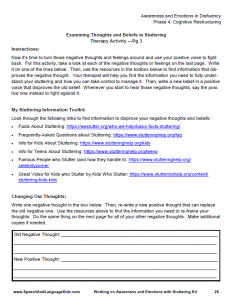Stuttering Assessment:
How to do a Fluency Evaluation
Stuttering, the most common fluency disorder, is an interruption in the flow of speaking characterized by specific types of disfluencies, including
- repetitions of sounds, syllables, and monosyllabic words (e.g., “Look at the b-b-baby,” “Let’s go out-out-out”);
- prolongations of consonants when it isn’t for emphasis (e.g., “Ssssssssometimes we stay home”); and
- blocks (i.e., inaudible or silent fixation or inability to initiate sounds).
These disfluencies can affect the rate and rhythm of speech and may be accompanied by
- negative reactions to speaking;
- avoidance behaviors (i.e., avoidance of sounds, words, people, or situations that involve speaking);
- escape behaviors, such as secondary mannerisms (e.g., eye blinking and head nodding or other movements of the extremities, body, or face); and
- physical tension.
Overview of Conducting a Stuttering Assessment:
Stuttering Assessment Step 1:
Evaluate General Foundations for Fluent Communication
-
- Determine if concomitant speech, language, hearing disorders exist
- Use hearing screening, speech and voice eval, language eval
Stuttering Assessment Step 2:
Obtain Background Information
-
- Determine perceptions of fluency problem by parents, family, teachers, and client
- Determine impact of fluency disorder on social, academic, and work performance
- Use interviews, case history, reports from other professionals and family members
Stuttering Assessment Step 3:
Perform Published Testing on Overt and Covert Features
-
- Determine if a problem exists, what kind of problem, and its severity by comparing client’s scores to standardized norms
- Determine communication attitudes and self-concept
- Use standardized tests
Stuttering Assessment Step 4:
Perform Non-Standardized Testing
-
- Determine overt behavior features of speech disfluency (type, frequency, core behaviors, speech rates)
- Explore use of covert and struggle features
- See how responsive the child is to different techniques or types of therapy
- Use to determine direction and method of treatment
- Do this through analysis of a speech sample using a variety of behavioral observations and rate calculations
- Be sure to talk about emotions and communication attitudes during this to probe deeper into emotional implications
Stuttering Assessment Step 5:
Evaluate Relevant Environments
-
- Determine total resources for treatment
- Look for obstacles to success in academic or social areas
- Do this through an assessment of home environment and classroom demands
Source:
Diagnosis and Evaluation in Speech Pathology (Seventh Edition) by William O. Haynes and Rebekah H. Pindzola

About the Author: Carrie Clark, MA CCC-SLP
Hi, I’m Carrie! I’m a speech-language pathologist from Columbia, Missouri, USA. I’ve worked with children and teenagers of all ages in schools, preschools, and even my own private practice. I love digging through the research on speech and language topics and breaking it down into step-by-step plans for my followers.
Connect with Me:







Thank you so much. Very helpful.
Hi Carrie,
Do you use a standarized fluency assessment for preschoolers? If so, which do you use? Also, which expressive and receptive, and speech assessments do you use? Thank you
Hello, Debra!
Thank you so much for reaching out. Unfortunately, we get a ton of questions every day about how to solve specific speech/language problems. Since we have such a small staff, we aren’t able to answer every question that comes through on the website, social media, or via email. If you are a parent, we suggest you reach out to a local speech-language pathologist who can work with your child directly and answer your question.
If you are another speech-language professional, we have created a membership where we pay a full staff to answer questions like this on a regular basis. We would be more than happy to answer your question inside the membership program. We’re able to answer more questions in here because we have a full library of questions that we’ve already answered so our staff can either link you to the answer if it exists, or write you a custom response if needed. We’d love to see you inside the membership!
Click Here to Become a Member: https://www.slpsolution.com/pediatric-signup/
Great! This is what I am looking for. Thanks